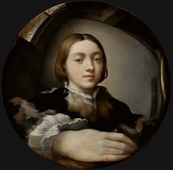Details
Fragment of the healing of the Crippel at the Beautiful Gate - Ca. 1530
Left part fragment of a larger etching: St. Peter and St. John Healing the Cripple at the Beautiful Gate. Ca 1530
Bartsch XVI.9.27 I / III
After Raphael (1483-1520)
As described in the sublime description in the Kirk Edward Long collection (L.15.172.2007) by Dr. Bernard Barryte (Iris & B. Gerald Cantor Center for Visual Arts-2015) this print was based by Parmigianino on the Raphael designed series of tapestries for the Sistine Chapel.
It is generally agreed that Parmigianino was responsible for the design drawing for the etching while he probably involved a professional etcher (Master F.P.?) to make the actual etching.
This is a first state in pure etching. Second and third state are printed with respectively one and two toned woodblocks to create a chiaroscuro print.
Restoration of paper los in bottom section. Fragment of a much larger plate (27,10 x 38,60 cm)
Additional Information
| SKU | xxs15 |
|---|---|
| Picture Size | 18 x 8,50 cm |
| Specification | |
| technic | Engraving |
| Artist | Parmigianino |
| period | 16th Century |
| School | Italian |
| subject | Mythology |
| rating | **** |
Parmigianino (1503-1540) Also known as Parmigianino; Mazzola, Girolamo Francesco Maria; Parmigianino, Francesco; Mazzuoli, Francois; Mazzuoli, Francesco Painter, etcher and designer for engraving and woodcut, exponent of Mannerism with an emphasis on elongated forms, worked in Parma, Rome and Bologna. After the death of his father, Filippo Mazzola, in 1505, Parmigianino was brought up by his uncles Michele and Pier Ilario Mazzola. Like his father, they were painters, and according to Vasari it was from them that he received his earliest training.
Also known as Parmigianino; Mazzola, Girolamo Francesco Maria; Parmigianino, Francesco; Mazzuoli, Francois; Mazzuoli, Francesco Painter, etcher and designer for engraving and woodcut, exponent of Mannerism with an emphasis on elongated forms, worked in Parma, Rome and Bologna. After the death of his father, Filippo Mazzola, in 1505, Parmigianino was brought up by his uncles Michele and Pier Ilario Mazzola. Like his father, they were painters, and according to Vasari it was from them that he received his earliest training.
'Left: Self-Portrait in Convex Mirror'
All the items are guaranteed to be originals and as described.
A letter of authenticity is added by simple request.
Items may be returned within 15 days after arrival.
I ship worldwide and provide Insurance and other delivery options.
All items can be purchased instantly at the listed prices,
on reservation of errors in price or availibility..






 Facebook
Facebook Twitter
Twitter Subscribe us
Subscribe us Flickr
Flickr




